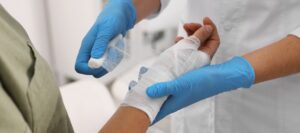
The body naturally produces sweat in order to cool itself off, but hot weather and physical exertion are not the only causes of sweat. We also sweat because of emotional stress, anxiety or a case of the nerves. It is estimated that 1% of Americans sweat excessively. Excessive sweating can entail as much as 4x the amount of sweat a normal person produces as the body tries to maintain a normal temperature. This condition is called primary hyperhidrosis; it most commonly impacts the palms of the hands, the feet and the armpits.
Excessive sweating can make you self-conscious and even interfere with your work or social life. Plus, consistently moist skin leaves you more vulnerable to infections. If you’re sweating more than you think is normal, you know good and well that over-the-counter antiperspirants don’t help the problem. You’re likely willing to try just about anything to make the problem stop—and so, you stumbled upon Botox. But does it really work?
Yes! Botox is a great way to treat hyperhidrosis. It is especially beneficial if hyperhidrosis impacts your underarms. It still works but is slightly less desirable for your hands and feet. That’s because it can be more painful to get Botox injections in the palms of your hands and soles of your feet, as these are very sensitive areas of the body.
How Does Botox Work To Prevent Excessive Sweating?
Botox is a neurotoxin produced by bacteria found in soil known as Clostridium botulinum. It has adverse effects on muscle control, with the potential to cause blurry vision, drooping eyelids and difficulty breathing or swallowing, as well as muscle weakness and paralysis. All of these things sound scary, but Botox is very safe as long as a licensed professional in a sterile medical environment administers it.
The middle layer of your skin, the dermis, is made up of collagen, elastin, sweat glands, hair follicles, sebaceous glands, nerve endings and blood vessels. There are two different glands that produce sweat: the eccrine and apocrine glands. You have eccrine glands all over your skin, but apocrine glands are only found in areas with high concentrations of hair follicles, like your groin, armpits and scalp.
Both the eccrine and apocrine glands are controlled by the sympathetic and parasympathetic nervous systems, the same command center in charge of other involuntary functions like digestion, body temperature, heart rate and so forth. When your body temperature spikes, your sympathetic nervous system is naturally programed to signal your sweat glands into action to cool off your body.
Injecting Botox into the skin impacts the signal that stands between the nerve endings and the sweat glands in the dermis. The botulinum toxin attaches itself to the nerve endings and then acts like a road block against the release of the neurotransmitter acetylcholine, a chemical our body uses to communicate. This disruption in communication prevents the body from sweating. Of course, as soon as Botox wears off, full perspiration capabilities return.
How Long Will Botox Injections Stop Me From Sweating?
Each treatment generally includes injecting Botox into several spots concentrated in the affected area. Botox starts working almost immediately, and reaches its peak point at around 3 days to one-week post-injections. It should last for 3 to 6 months depending on the quality of the solution and how your body reacts to it.
Is Botox Approved To Treat Sweating?
Back in 2004, the US Food and Drug Administration approved Botox injections for the treatment of axillary hyperhidrosis (excessive sweating of the armpits). Some doctors use Botox to treat palmar hyperhidrosis (excessive sweating of the palms), as well as plantar hyperhidrosis (excessive sweating of the feet).
Is Botox Safe?
Botox is one of the most highly regulated and well-tested drugs used by humans. There are no confirmed cases of Botox spreading away from the injection site when used to treat excessive underarm sweating.
For the most part, Botox is incredibly safe. But just like with anything, some people are allergic to it. Serious allergic reactions are rare but can happen. Common symptoms include: generalized muscle weakness, blurry vision, or dizziness. If any of these things impact you within days or weeks of injections, visit a doctor right away.
Urgent Medical Center is a proud provider of Botox. Contact us today to learn more and gain control of excessive sweating.





